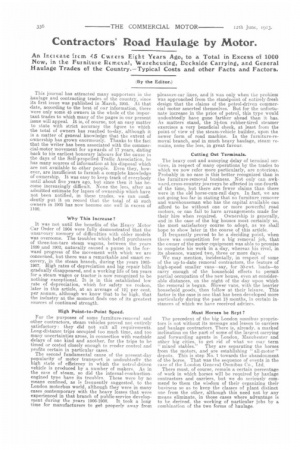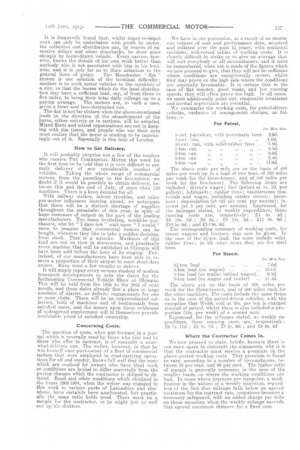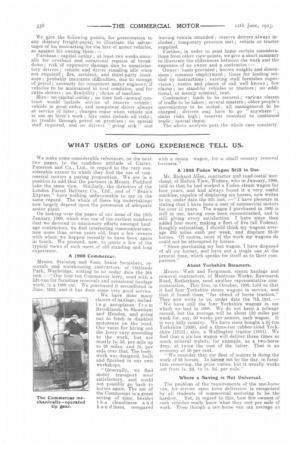Contractors' Road Haulage by Motor.
Page 14

Page 15

Page 16

If you've noticed an error in this article please click here to report it so we can fix it.
An Incleas.e Item 45 Cytrers Eight Years Ago, to a Total in Excess of 1000 Now, in the Furnituie 14(tnexa1, Warehcusing, Dcckside Carrying, and General Haulage Trades of the Country.—Typical Costs and other Facts and Factors.
by the Editor.) This journal has attracted many supporters in the haulage and contracting trades of the country, since its first issue was published in March, 1905. At that date, according to the best of our information, there were only some 45 owners in the whole of the important trades to which many of the pages in our present issue will appeal. It is, of course, not an easy matter to state with strict accuracy the figure to which the total of owners has reached to-day, although it is a, matter of general knowledge that the extent of ownership has grown enormously. Thanks to the fact that the writer has been associated with the commercial-motor movement for upwards of 17 years, dating back to his earliest honorary labours for the cause in the days of the Self-propelled Traffic Association, he has many sources of information at his disposal which are not available to other people. Even they, however, are insufficient to furnish a complete knowledge of ownership. It, was easy to keep track of everybody until about five years ago, but since then it has become increasingly difficult. None the less, after an admitted estimate for lapses of ownership which have not been notified, in these trades, we can confidently put it on record that the total of 45 such owners in 1905 has now become one yell in excess of 1100.
Why This Increase?
It was not until the benefits of the Heavy Motor -Car Order of 1904 were fully demonstrated that the unsavoury memory of difficulties with older models was overcome. The troubles which befell purchasers of three-ton-tare steam wagons, between the years 1899 and 1902, naturally caused a pause in the forward progress of the movement with which we are concerned, but there was a remarkable and smart recovery, in the steam branch, during the years 19051907. High rates of depreciation and big repair bills gradually disappeared, and a working life of ten years for a steam warn or tractor is now recognized to be nothing exceptional It is in this established low rate of depreciation, which for safety we reckon, later in this article, at an average of 121 per cent. per annum, although we know that to be high, that the industry at the moment finds one of its greatest sources of continued strength.
High Point-to-Point Speed.
For the purposes of some furniture-removal and other contractors, steam vehicles proved not entirely satisfactory : they did not suit all requirements. Long-distance trips occupied too much time, and too many uncertainties arose, in connection with roadside delays of one kind and another, for the trips to be timed or anted closely enough to render control and profits certain in particular cases.
The second fundamental cause of the present-day popularity of motor transport is undoubtedly the high state of efficiency in which the petrol-driven vehicle is produced by a number of makers. As in the case of steam, so did the internal-cnmbustionengined tyne have its troubles. These were by no means confined, as is frequently suggested. to the London motorbus world, although they were in many cases contemporary with the heavy losses that were experienced in that branch of public-service development during the years 1906-1908. It took a long time for manufacturers to get properly away from pleasure-ear lines, and it was only when the problem was approached from the standpoint of entirely-fresh design that the claims of the petrol-driven commercial motor asserted themselves. But for the unfortunate increase in the price of petrol, this type would undoubtedly have gone farther ahead than it has. As matters stand, the ai-ton rubber-tired steamer exercises a very beneficial check, at least from the point of view of the steam-vehicle builder, upon the newer form of road machine. In the furniture-removal branch, and in much heavy haulage, steam remains, none the less, in great favour.
Cutting out Terminals.
The heavy cost and annoying delay of terminal services, in respect of many operations by the trades to which we now refer more particularly, are notorious. Probably in no ease is this better recognized than in the furniture-removal business. Not only can awkward, cross-country journeys be effected in one-fourth of the time, but there are fewer claims than there were in the old horse-cum-rail days. In fact, we are not going too far in stating that no furniture remover and. warehouseman who has the capital available can afford to be without one or more powerful road motors, or can fail to have arrangements made for their hire when required. Ownership is generally, and in the case of the big houses most certainly so, the most satisfactory course to adopt, as we shall hope to show later in the course of this article. It frequently proved to be a deciding point, when there was competition for a big removal job, that the owner of the motor equipment was able to promise to complete his work in a day, whereas his rival, in its absence, wanted two, three or more days. We may mention, incidentally, in respect of some of the up-to-date removal contractors, the feature of high-speed smaller vans—say, for 30-cwt. loads—to carry enough of the household effects to permit partial occupation of the new house, even at considerable distances, on the night of the day upon which the removal is begun. Slower vans, with the heavier household goods, then follow at their leisure. This factor in the case is one that has been developed more particularly during the past 18 months, in certain instances of which we have received advices.
Must Horses be Kept ?
The precedent of the big London omnibus proprietors is not without its message and lesson to carriers and haulage contractors. There is, already, a marked inclination on the part of some of the largest carrying and forwarding agents in London, Manchester and other big cities, to get rid of what we may term " mixed stables." They are separating the horses from the motors, and are establishing " all-motor" depots. This is step No. 1 towards the abandonment of the horse. That was the sequence of events in the ease of the London General Omnibus Co.. Ltd.
There must, of course, remain a certain percentage of work in which horses will be required by haulage contractors and carriers, but we do seriously commend to them the wisdom of their organizing their business so as to keep the classes of plant distinct one from the other, although this need not by any means eliminate, in those cases where advantage is to be derived, the working of particular jobs by a combination of the two forms of haulage. It is frequently found that, whilst depot-to-depot work can only be undertaken with profit by motor, the collection and distribution can, by reason of excessive delays and other drawbacks, be done more cheaply by horse-drawn vehicle. Every carrier, however, knows the details of his own work better than anybody who is not associated with him in his business, and it is only for us to draw attention to the
general hues of policy. The Manchester " fiat " system is one solution of the terminal difficulty : another is to work motor vehicles to the outskirts of a. city, so that the horses which do the local distribution may have a sufficient lead, say, of from three to five miles, to bring their total daily mileage up to a paying average. The motors are, in such a case, given a freer and less-obstructed run.
The day is not far distant when the above-mentioned leads in the direction of the abandonment of the horse, either entirely or in sections, will be adopted. Mixed fleets and mixed organizations are not in keeping with the times, and people who use their eyes must realize that the horse is tending to be increasingly out of it. Especially is this true of London.
How to Get Delivery.
It will probably surprise not a few of the traders who receive Tun COMMERCIAL MOTOR this week for the first time to be told that it is very difficult to get early delivery of any considerable number of vehicles. Taking the whole range of commercial motors, from the pa.reelear to the five-tonner, we doubt if it would be possible to obtain delivery, between this and the end of July, of more than 150 machines. There is a keen demand for all.
With railway strikes, labour troubles, and other pro-motor influences looming ahead, we anticipate that there will be a distinct shortage of supplies throughout the remainder of this year, in spite of huge increases of output on the part of the leading manufacturers. Too many hesitating, would-be purchasers, who let "I dare not" wait upon "I would," seem to imagine that commercial motors can be bought, whenever they like to take a sudden decision, from. stock. That is a mistake. Machines of this kind are not on view in showrooms, and practically every machine that will be exhibited at Olympia will have been sold before the hour of its staging. Few, indeed, of our manufacturers have been able to reserve a proportion of their output to meet short-date orders. Many want a few months to deliver.
It will amply repay every serious student of modern transport developments to note the dates for the forthcoming Commercial Vehicle Show at Olympia. This will be held from the 18th to the 26th of next month, and those dates already find a place in large numbers of diaries, as definite engagements for one or more visits. There will be an unprecedented collection, both of machines and of testimonials from satisfied users, and the names upon those evidences of widespread employment will in themselves provide irrefutable proof of satisfied ownership.
Concerning Costs.
The question of costs, when put forward in a journal which is severally read by those who hire and by those who offer to contract, is of necessity a somewhat-delicate one. The writer, however, in that he was himself once part-owner of a fleet of commercial motors that were employed in road-carrying operations for all and sundry, knows full well that the costs which are realized by owners who have ideal work or conditions are bound to differ materially from the paying charges which the contractor is obliged to demand. Road and other conditions which obtained in the years 1902-1904, when the writer was engaged in this work in various parts of Lancashire and elsewhere, have certainly been ameliorated, hut practically the same ratio holds good. There must be a margin for the contractor, or he might just as well put up his shutters.
We have in our possession, as a result of an enormous volume of cost and performance data, acquired and collated over the past 13 years, with continual revisions, well-tested tables of working costs. it is clearly difficult to strike or to give an average that will suit everybody or all circumstances, and it must be remembered, when use is made of the figures which we now proceed to give, that they will not be sufficient where conditions are exceptionally severe, whilst they may prove on the high side where the conditions are unusually favourable. It is certain that in the case of flat country, good roads, and low running speeds, they will often prove too high. In all cases, we must additionally point out, reasonable treatment and normal supervision are essential. We summarize the working costs, for petrol-driven vehicles, exclusive of management charges, as follows :—
The above costs per mile are on the basis of 400 miles per week up to a load of two tons, of 350 miles per week for the three-tonner, and of 300 miles per week for the five-tonner. The following items are included: driver's wages ; fuel (petrol at is. 3d. per gallon); lubricants ; rubber tires ; maintenance (materials and wages, including sundry stores); insurance ; depreciation (at 12i per cent. per annum); interest (at 5 per cent. per annum). Expressed, for the mileages stated, in weekly expenditure, these running costs are, respectively : 21 5s. 4d. ;
£6 13s. E6 6s. ; 28 12s. 2421. ; 211 Os. 8(1. ; £12 Sc, 9d.; and 9s. 6d. The corresponding summary of working costs, for steam wagons and tractors, may now be given. In the case of the 31-ton load, the costs include solidrubber tires ; in all other cases they are for steel tires.
9-ton load (on wagon and trailer) The above are on the basis of 300.l
milAd.
les per week for the three-tonner, and of 200 miles each for the other machines. The costs include the same items as in the case of the petrol-driven vehicles, with the exception that Welsh coal at 28s. per ton is charged instead of petrol, whilst there is also included a proportion (15s., per week) of a second man. Expressed, for the mileages stated, as weekly expenditure, these running costs are, respectively £9 75. lid.; £8 Si. 7d. ; 28 2s. 9d.; and 20 9s. 44.
Where the Contractor Comes In.
We now proceed to state, briefly, because there is not more space to elaborate the arguments, why it is that the contractor must receive a premium on the above-quoted working costs. That premium is found to vary, according to a number of circumstances, between 33 per cent. and GO per cent. The higher ratio of margin is generally necessary in the case of the smaller loads, or where the working conditions are bad. In cases where journeys arc irregular, a modification in the nature of a weekly minimum, regardless of the fact that mileage falls below an agreed maximum for the contract rate. sometimes becomes a necessary safeguard, with an added charge per mile on those occasions when the weekly mileage exceeds that agreed maximum distance for a fixed sum. We give the following points, for presentation to any dilatory freight-payer, to illustrate the advantages of his contracting for the hire of motor vehicles, as against his owning them :— Purchase : capital outlay ; at least two weeks annually for overhaul and occasional repairs of breakdown ; risk of expensive damage due to unsatisfactory drivers ; vehicle and driver standing idle when not required ; fire, accident, and third-party insurance; probably insurance difficulties, due to storage of petrol; necessity for competent motor engineer, if vehicles to be maintained in best condition, and for extra drivers ; no flexibility ; choice of machine. Hire : no capital outlay ; no time lost--annual contract would include service of reserve vehicle ; vehicle in good order, and competent driver always at service of hirer; charges cease when vehicle not in use on hirer's work ; hire rates include all risks; no trouble through petrol on premises ; DO special staff required, and no drivers " going sick " and leaving vehicle stranded ; reserve drivers always ineluded; temporary pressure met; vehicle or tractor supplied. Eurther, in order to send home certain considerations from other view-points, we give a, short summary to illustrate the differences between the work and the expenses of an owner and a contractor :— Owner loads provided ; known weights and dimensions; common employment ; times for loading settled by instructions ; existing staff furnishes supervision; routes and places of call well known ; few claims ; no stand-by vehicles or tractors ; no additional, or merely nominal, rent. Contractor : loads to be secured ; various classes of traffic to be taken; several masters; other people's conveniences to be suited ; all management to be charged; drivers may have to go " anywhere " claim risks high ; reserves essential to continued trade ; special depot. The above analysis puts the whole case concisely.






























